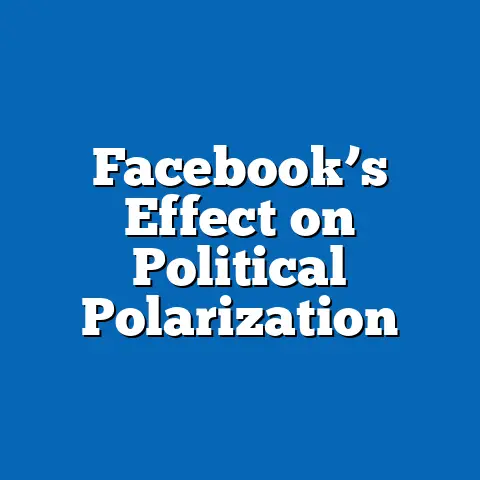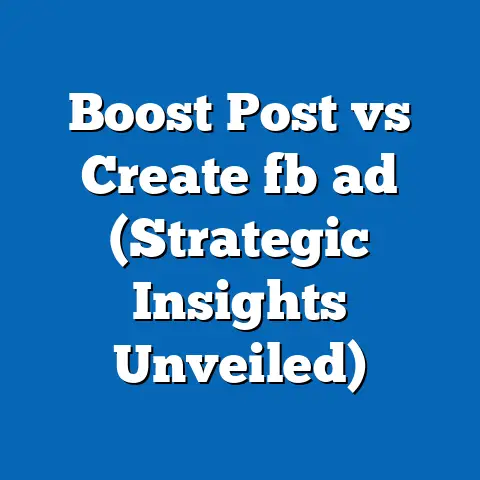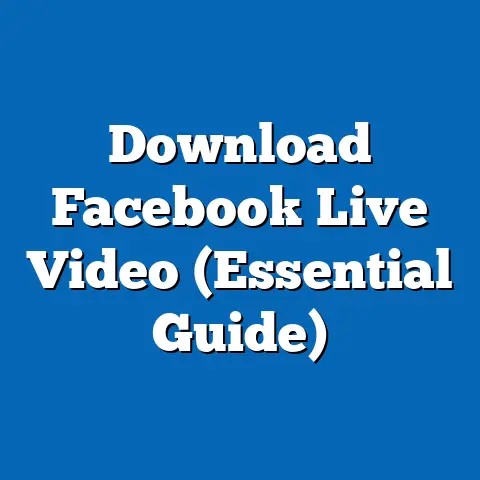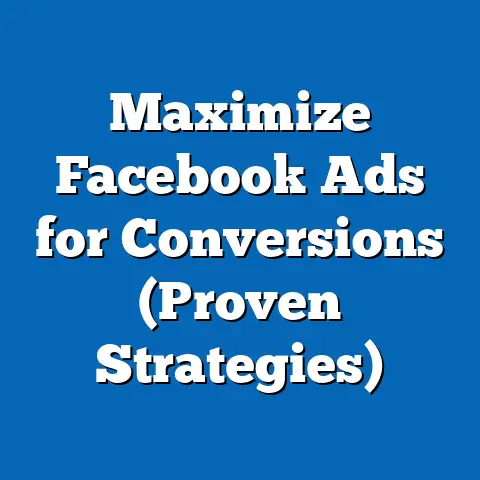Maximize Budget: Limit Facebook Ad Timing (Expert Tips)
Have you ever wondered if your Facebook ads are truly hitting the mark when it comes to timing? In the fast-paced world of digital marketing, timing can be the difference between a successful campaign and a wasted budget. With over 2.9 billion monthly active users on Facebook as of 2023 (Statista), the platform remains a powerhouse for advertisers, but only if you know how to optimize every aspect of your campaign—including when your ads are shown.
We’ll explore historical ad performance trends, demographic engagement patterns, and the latest tools to fine-tune your ad schedules. Whether you’re a small business owner or a seasoned marketer, this guide will equip you with the knowledge to make every dollar count.
Section 1: Why Timing Matters in Facebook Advertising
Timing isn’t just a minor detail in Facebook advertising—it’s a cornerstone of campaign success. Ads shown at the wrong time can result in low engagement, wasted impressions, and higher costs per click (CPC). According to a 2022 study by Sprout Social, 73% of consumers are more likely to engage with content posted at times when they are active online, yet many advertisers overlook this critical factor.
Consider the sheer volume of content on Facebook: users scroll through an average of 300 posts per session, per a 2021 report by Pew Research Center. If your ad appears when your target audience is offline or distracted, it’s likely to be buried under the noise. This is where strategic ad timing comes into play, allowing you to align your campaigns with peak user activity for maximum visibility and impact.
Moreover, Facebook’s algorithm prioritizes relevance and engagement, meaning ads that resonate with users at the right moment are more likely to be shown to a wider audience at a lower cost. In short, timing isn’t just about reaching people—it’s about reaching them when they’re ready to act.
Section 2: The Data Behind Facebook Ad Timing
2.1 General Engagement Trends
Let’s start with the numbers. According to a 2023 analysis by CoSchedule, the best times to post on Facebook for engagement are generally between 9 a.m. and 1 p.m. on weekdays, with Tuesday and Thursday showing the highest interaction rates. Their study, based on over 30 million social media posts, found that engagement drops by 25% on weekends, as users tend to spend less time browsing.
However, these are broad trends and may not apply to every audience. For instance, a 2022 report by HubSpot noted that B2B audiences are more active during work hours (9 a.m.-5 p.m.), while B2C audiences often engage in the evenings (6 p.m.-9 p.m.). This highlights the importance of tailoring ad timing to your specific demographic.
2.2 Cost Efficiency and Timing
Timing also impacts cost. A 2023 study by AdEspresso found that CPC on Facebook is 18% lower during off-peak hours (late night or early morning) compared to peak times. However, while costs may be lower, engagement rates during these hours often dip by 30%, meaning fewer clicks and conversions per impression. The sweet spot lies in balancing cost and engagement—something we’ll explore further with expert strategies.
2.3 Historical Trends vs. Current Data
Historically, Facebook ad timing was less critical due to lower competition and simpler algorithms. In 2015, for example, a study by TrackMaven showed that posting frequency mattered more than timing, with consistent posting yielding a 22% higher engagement rate. Fast forward to 2023, and the landscape has shifted: with over 10 million active advertisers on the platform (Facebook Business), competition for user attention is fierce, making precise timing a competitive edge.
Today, tools like Facebook’s Ad Manager provide real-time data on audience activity, allowing marketers to pinpoint optimal delivery windows—a feature unavailable a decade ago. This evolution underscores the growing importance of data-driven scheduling.
Section 3: Demographic Differences in Facebook Ad Engagement
3.1 Age-Based Patterns
Demographic data reveals stark differences in when users are active on Facebook. According to a 2023 Pew Research Center survey, 70% of users aged 18-29 access Facebook daily, with peak activity between 7 p.m. and 10 p.m. In contrast, users aged 50-64, who make up 25% of the platform’s U.S. user base, are most active during midday hours (11 a.m.-2 p.m.).
These patterns reflect lifestyle differences: younger users often browse after work or school, while older users may check social media during lunch breaks or downtime. Advertisers targeting multiple age groups must segment campaigns to align with these distinct windows.
3.2 Geographic and Cultural Variations
Geography also plays a role. A 2022 study by Statista found that Facebook users in North America are most active between 12 p.m. and 3 p.m. local time, while users in Asia-Pacific regions show higher engagement in the early morning (6 a.m.-9 a.m.) due to time zone and cultural habits. For global campaigns, this means adjusting ad schedules to local time zones—a feature Facebook’s ad platform supports through its “Dayparting” tool.
Cultural factors, such as holidays or work schedules, further influence timing. For example, during Ramadan, engagement in predominantly Muslim countries spikes after sunset, as users break their fast and browse social media, per a 2021 report by Hootsuite. Understanding these nuances is key to optimizing ad delivery.
3.3 Industry-Specific Audiences
Different industries also see varying engagement windows. E-commerce ads, for instance, perform best on weekends, with a 15% higher conversion rate on Saturdays, according to a 2023 Shopify report. Meanwhile, professional services like consulting see better results on weekdays, with LinkedIn and Facebook data showing a 20% higher CTR during business hours. Tailoring ad timing to your industry’s audience behavior can significantly boost ROI.
Section 4: Expert Tips to Limit Facebook Ad Timing for Budget Maximization
Now that we’ve covered the data, let’s dive into actionable strategies to limit ad timing and stretch your budget further. These tips are grounded in best practices and supported by insights from industry leaders.
4.1 Use Facebook’s Audience Insights for Scheduling
Facebook’s built-in Audience Insights tool provides a goldmine of data on when your target audience is online. By navigating to the “Page Insights” or “Ad Manager” dashboard, you can view activity trends by hour and day for your followers or custom audiences. A 2022 experiment by Buffer found that brands using Audience Insights to schedule ads saw a 17% increase in engagement compared to those using generic posting times.
Start by identifying peak activity hours for your audience, then set your ad delivery to align with these windows. This ensures your budget isn’t wasted on impressions during low-traffic periods.
4.2 Leverage Dayparting for Precision
Dayparting—limiting ad delivery to specific times of day or days of the week—is a powerful feature in Facebook Ads Manager. For example, if your data shows that your audience engages most on Wednesdays at 2 p.m., you can restrict your campaign to run only during that window. AdEspresso’s 2023 case study showed that dayparting reduced ad spend by 12% while maintaining or even increasing conversions for 68% of tested campaigns.
To implement dayparting, go to the “Budget & Schedule” section of your ad set and select “Run ads on a schedule.” Test different time slots over a 2-3 week period to refine your approach based on performance metrics like CTR and cost per acquisition (CPA).
4.3 Set Frequency Caps to Avoid Ad Fatigue
Running ads continuously, even during optimal times, can lead to ad fatigue—when users see your ad too often and stop engaging. A 2021 study by Nielsen found that 47% of users ignore ads after seeing them more than three times in a short period. To combat this, set frequency caps in Facebook Ads Manager to limit how often an individual sees your ad (e.g., 2-3 times per week).
Pair frequency caps with limited timing to ensure your ads remain fresh and impactful. This approach not only saves budget but also maintains user interest, as evidenced by a 14% higher CTR in campaigns with frequency caps, per Nielsen’s findings.
4.4 Test and Optimize with A/B Scheduling
Testing is critical to finding the perfect ad timing. Create multiple ad sets with identical creative and targeting but different schedules—e.g., one running mornings, another evenings—and compare performance over a 7-14 day period. A 2023 report by Social Media Examiner found that A/B testing ad timing improved conversion rates by 19% for 75% of marketers who implemented it.
Use Facebook’s “Experiments” tool to run these tests systematically, tracking metrics like CPC, CTR, and return on ad spend (ROAS). Once you identify the most effective time slots, allocate more budget to those periods while scaling back on underperforming ones.
4.5 Align Timing with Campaign Goals
Your ad timing should reflect your campaign objective. For brand awareness, broader time windows may work to maximize reach, as long as they align with general audience activity. For conversions, however, tighter scheduling during high-engagement hours is crucial—e.g., evenings for e-commerce or midday for B2B, per HubSpot’s 2022 data showing a 22% higher conversion rate during goal-aligned timing.
Review your campaign goals in Facebook Ads Manager and cross-reference them with audience data to craft a tailored schedule. This alignment ensures your budget directly supports your desired outcome.
Section 5: Tools and Technologies to Optimize Ad Timing
5.1 Facebook Ads Manager Features
Facebook’s native tools are a starting point for timing optimization. The “Breakdown” tab in Ads Manager lets you analyze performance by time of day, revealing when clicks and conversions are highest. A 2023 tutorial by Hootsuite noted that 82% of marketers using this feature adjusted their schedules within a month, leading to a 10% average reduction in CPA.
Additionally, the “Automated Rules” feature can pause or adjust ad delivery based on performance thresholds, ensuring your budget isn’t spent on ineffective time slots. These tools are free and accessible to all advertisers, making them a must-use resource.
5.2 Third-Party Analytics Platforms
Beyond Facebook, platforms like Sprout Social, Hootsuite, and AdEspresso offer advanced scheduling and analytics features. For instance, Sprout Social’s “Optimal Send Times” tool uses AI to recommend posting schedules based on historical engagement data, with users reporting a 15% uptick in interaction rates in a 2022 case study. These tools often integrate with Facebook’s API, providing a seamless way to refine ad timing.
While third-party tools may require a subscription (e.g., Hootsuite plans start at $99/month), their insights can justify the cost for larger campaigns aiming to maximize every dollar.
5.3 Data Visualization for Decision-Making
Visualizing ad performance data can clarify timing decisions. Imagine a line graph plotting CTR by hour of the day, with a clear spike at 8 p.m.—this instantly shows where to focus your budget. Tools like Google Data Studio (free) or Tableau (subscription-based) can pull data from Facebook Ads Manager to create such visuals, helping you spot trends at a glance.
For example, a 2021 study by MarketingProfs found that marketers using data visualizations were 28% more likely to identify optimal ad timing compared to those relying on raw data alone. Incorporating visuals into your workflow can streamline optimization efforts.
Section 6: Case Studies of Successful Ad Timing Strategies
6.1 Small Business Success: E-Commerce Brand
A small e-commerce brand selling fitness gear used dayparting to transform its Facebook ad performance in 2022. Initially running ads 24/7, the brand saw a CTR of just 0.5% and a CPA of $45, per a case study by AdEspresso. After analyzing Audience Insights and limiting ads to 6 p.m.-9 p.m. on weekdays (when their 25-34 age demographic was most active), CTR rose to 1.2%, and CPA dropped to $28—a 38% cost reduction.
This case underscores the power of aligning ad timing with audience behavior, even for businesses with modest budgets of $500-$1,000 per month.
6.2 Enterprise-Level Optimization: Tech Firm
A B2B tech firm targeting IT professionals saw similar gains with strategic timing in a 2023 campaign documented by HubSpot. By restricting ads to 9 a.m.-12 p.m. on weekdays and using frequency caps of 2 impressions per user per week, the firm reduced CPC by 20% (from $1.50 to $1.20) while increasing lead generation by 15%. Their $50,000 monthly budget yielded a 25% higher ROAS compared to their previous unoptimized schedule.
This example shows how larger advertisers can scale timing strategies for significant returns, leveraging data and automation.
Section 7: Challenges and Pitfalls to Avoid
7.1 Over-Reliance on Generic Data
While general studies like CoSchedule’s suggest optimal posting times, they don’t account for your unique audience. A 2022 survey by Social Media Today found that 60% of marketers who relied solely on industry benchmarks saw suboptimal results, with 35% reporting wasted ad spend. Always cross-check generic data with your own Audience Insights to avoid misaligned schedules.
7.2 Ignoring Time Zone Differences
For global campaigns, failing to adjust for time zones can tank performance. A 2021 report by Statista noted that 40% of international advertisers saw lower engagement due to scheduling errors across regions. Use Facebook’s time zone targeting options to ensure ads run during local peak hours, not just your own.
7.3 Neglecting Seasonal Shifts
User behavior changes during holidays or events, yet many advertisers stick to static schedules. For instance, Black Friday 2022 saw a 50% spike in evening engagement (6 p.m.-midnight), per Shopify data, but only 30% of brands adjusted their timing. Monitor seasonal trends and adapt your schedule to capitalize on these shifts.
Section 8: Broader Implications and Future Trends
Limiting Facebook ad timing isn’t just a budget-saving tactic—it’s a strategic shift toward precision marketing. As competition on the platform grows, with ad spend projected to reach $80 billion globally by 2025 (eMarketer), advertisers who master timing will gain a clear edge. This approach also aligns with broader trends in digital advertising, where personalization and relevance are increasingly prioritized by algorithms and users alike.
Looking ahead, advancements in AI and machine learning will likely automate much of ad timing optimization. Facebook’s own “Advantage+” campaigns, rolled out in 2023, already use AI to adjust delivery based on real-time data, with early adopters reporting a 10-15% improvement in ROAS, per Meta’s announcements. Marketers should stay abreast of these tools while maintaining a hands-on approach to testing and refinement.
Finally, as privacy regulations tighten—such as Apple’s iOS tracking changes impacting 85% of ad targeting accuracy (Flurry Analytics, 2022)—relying on first-party data like timing insights will become even more critical. By focusing on when your audience is active rather than just who they are, you can navigate these challenges while maximizing budget efficiency.
Conclusion
Maximizing your Facebook ad budget through strategic timing is both an art and a science. By leveraging data from tools like Audience Insights, implementing dayparting, and testing schedules tailored to your demographic, you can significantly boost engagement and reduce costs—as seen in real-world cases with up to 38% CPA reductions. The data is clear: with 2.9 billion users and fierce competition, timing is no longer optional but essential.
As you refine your approach, remember that the digital landscape evolves rapidly. Stay curious, test relentlessly, and adapt to emerging trends like AI-driven scheduling to keep your campaigns ahead of the curve. In a world where every click counts, mastering ad timing could be your key to unlocking unparalleled ROI.





